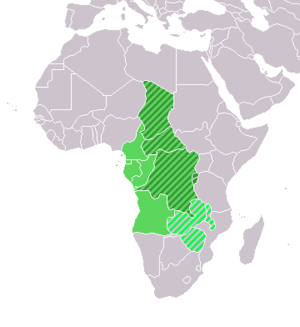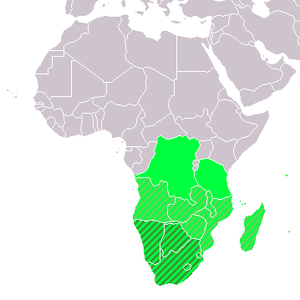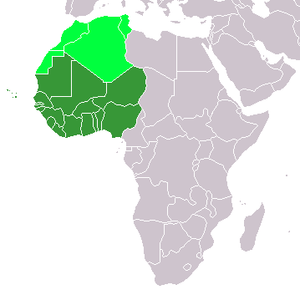Sub-Saharan Africa: Difference between revisions
Omniposcent (talk | contribs) |
Omniposcent (talk | contribs) No edit summary |
||
| Line 3: | Line 3: | ||
[[Image:Africa satellite orthographic.jpg|thumb|249px|Satellite image of Africa, showing the ecological break that defines the sub-Saharan area]] |
[[Image:Africa satellite orthographic.jpg|thumb|249px|Satellite image of Africa, showing the ecological break that defines the sub-Saharan area]] |
||
Sahara.<ref>http://exploringafrica.matrix.msu.edu/images/subsaharan.jpg</ref><ref>http://www.acdi-cida.gc.ca/subsaharanafrica</ref> |
|||
[[Image:Niger-Congo.png|thumb|249px|Linguistically, Sub-Saharan Africa is dominated by the [[Niger-Congo]] phylum (distribution shown in yellow), with pockets of [[Khoi-San]] in [[Southern Africa]], [[Nilo-Saharan languages|Nilo-Saharan]] in [[Central Africa|Central]] and [[East Africa]], and [[Afro-Asiatic languages|Afro-Asiatic]] in the [[Horn of Africa]]]] |
|||
'''Sub-Saharan Africa''' is a geographical term used to describe the area of the [[Africa]]n continent which lies south of the [[Sahara]], or those [[African countries]] which are fully or partially located south of the Sahara.<ref>http://exploringafrica.matrix.msu.edu/images/subsaharan.jpg</ref><ref>http://www.acdi-cida.gc.ca/subsaharanafrica</ref> |
|||
==Geography== |
==Geography== |
||
Revision as of 09:25, 30 May 2008

Geography
Sub-Saharan Africa covers an area of 24.3 million square kilometers.[3]
Since around 5,400 years ago [3], the Saharan and sub-Saharan regions of Africa have been separated by the extremely harsh climate of the sparsely populated Sahara, forming an effective barrier interrupted by only the Nile River in Sudan, though the Nile was blocked by the river's cataracts. The modern term sub-Saharan corresponds with the south of the Sahara desert. Tropical Africa and Equatorial Africa are sometimes used as alternative labels, due to the distinctive ecology of the region.
History
- East Africa
The Axumite Empire spanned the southern Sahara and the Sahel along the western shore of the Red Sea,
- West Africa
The Nok culture, known from a type of terracotta figure found in Nigeria, dating to 500 BC -AD 200.
There are a number of medieval kingdoms of the southern Sahara and the Sahel, based on trans-Saharan trade, including the Ghana Empire and the Mali Empire, Songhai Empire, the Kanem Empire and the subsequent Bornu Empire. The Benin Empire was a pre-colonial state of Nigeria (1440-1897).
- Southern Africa
Monomotapa was a medieval kingdom (c. 1250-1629) which used to stretch between the Zambezi and Limpopo rivers of Southern Africa in the modern states of Zimbabwe and Mozambique. It enjoys great fame for the ruins at its old capital of Great Zimbabwe.
The Zulu Kingdom (1817-1879) was a Southern African state in what is now South Africa. The small kingdom gained world fame during and after the Anglo-Zulu War.
Demography
The population of sub-Saharan Africa was 770.3 million in 2006. [4] The current growth rate is 2.3%. The UN predict for the region a population of nearly 1.5 billion in 2050.[5]
Sub-Saharan African countries top the list of countries and territories by fertility rate with 40 of the highest 50, all with TFR greater than 4 in 2008. All are above the world average except South Africa.
Economies
Generally, sub-Saharan Africa is the poorest region in the world, suffering from the effects of colonialism, economic mismanagement, local corruption. and inter-ethnic conflict. The region contains many of the least developed countries in the world. (See Economy of Africa.)
The sub-Saharan African countries form the bulk of the ACP countries.
Health care
In 1987, Bamako was the location of a WHO conference known as the Bamako Initiative that helped reshape the health policy of sub-Saharan Africa.[6] The new strategy dramatically increased accessibility through community-based healthcare reform, resulting in more efficient and equitable provision of services. A comprehensive approach strategy was extended to all areas of health care, with subsequent improvement in the health care indicators and improvement in health care efficiency and cost.[7][8]
Up to and including October 2006 many governments face difficulties in implementing policies aimed at mitigating the effects of the AIDS-pandemic due to lack of technical support despite a number of mitigating measures.[9]
List of countries

- Angola (also in SADC)
- Democratic Republic of Congo (also in SADC)
- Rwanda (also in EAC)
- Burundi (also in EAC)
- São Tomé and Príncipe
- Southern Sudan (autonomous region of Sudan with independence referendum in 2011)

]]

- Angola (also in ECCAS)
- Botswana
- Comoros
- Lesotho
- Madagascar (sometimes included, not part of the African continent)
- Malawi
- Mozambique
- Mauritius
- Namibia
- Seychelles
- South Africa
- Swaziland
- Zambia
- Zimbabwe

References
- ^ http://exploringafrica.matrix.msu.edu/images/subsaharan.jpg
- ^ http://www.acdi-cida.gc.ca/subsaharanafrica
- ^ Sahara's Abrupt Desertification Started By Changes In Earth's Orbit, Accelerated By Atmospheric And Vegetation Feedbacks
- ^ [1]
- ^ [2]
- ^ "User fees for health: a background". Retrieved 2006-12-28.
- ^ "Implementation of the Bamako Initiative: strategies in Benin and Guinea". Retrieved 2006-12-28.
- ^ "Manageable Bamako Initiative schemes". Retrieved 2006-12-28.
- ^ Xinhua - English
